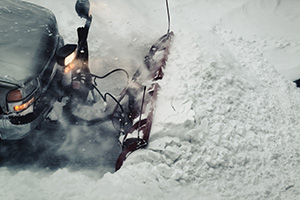Don’t let snow and ice take your business down.
By Sean Hartnett
When the skies open up, your business can’t afford to shut down. Even though a snow or ice storm is a reactive event, the reality is that having a snow removal/business continuity program in place puts you in control. While blizzards and ice storms can force stores and restaurants to close, even small amounts of snow and ice can also trigger headaches for facility maintenance teams and disrupt operations.
Your locations and the nature of your business will determine the extent of your snow removal/business continuity program. Before, during and after a storm, everybody is rushing to the grocery store, big box retailer and hardware store. They may not be racing to a restaurant, movie theater or vitamin shop. While all businesses clear snow, you can plan for the scope of work based on how weather events drive customer traffic, positively or negatively.
 The unpredictability of winter storms translates into a large spend variable. One year, you might have a “Snowmaggedon” on your hands, and the next, a mild winter that generates minimal snowfall. Having key data to examine past performance indicators of your snow removal efforts is a tremendous help, but the reality is, your costs will still have an element of volatility to them.
The unpredictability of winter storms translates into a large spend variable. One year, you might have a “Snowmaggedon” on your hands, and the next, a mild winter that generates minimal snowfall. Having key data to examine past performance indicators of your snow removal efforts is a tremendous help, but the reality is, your costs will still have an element of volatility to them.
Snow often elicits an emotional reaction from facilities managers because it’s an uncontrollable act of nature. They frantically want to get the snow and ice taken care of right now, so employees and customers can still get to the business unimpeded. That’s why having a snow removal/business continuity plan in place is key. No one wants to be on the phone or online desperately trying to find a snow removal service as a storm inches closer.
Losses due to blizzards are big money, even if your locations are closed for only a day. A recent HIS Global Insight Study reported that a 1-day shutdown in New York can add up to $152 million in lost retail sales. To avoid losing money, it’s critical to plan in advance. Consider the following to optimize your program:
- Let data drive your decisions. Which locations accounted for the biggest portion of your snow removal costs last year? Do you usually buy a seasonal contract at a guaranteed rate versus pay per occurrence? What is your baseline budget for snow removal and have you stayed within it in the past? If you’ve been working with a multi-site property management company that tracks extensive data and uses smart technology, these figures should be easy to locate and review. You need the complete picture to guide your decisions. Note: Many retailers spend an average of 3% to 10% of their facilities’ budget on snow and ice removal, depending on their size and geographical footprint.
- Plan now, benefit later. Work with your facilities maintenance team in the months before the first snowflake arrives to ensure you won’t be caught short in the winter. No detail is too small. For example, where is the excess snow dumped for each location? Exactly which areas need to be hand shoveled and salted? Does the company offer forecasting so you can be proactive? What’s the minimum snowfall amount that will automatically activate your snow removal service? Forgetting minor items can lead to major problems even with a relatively light snowfall.
- Manage all risks. Clearing snow and ice is critical to avoiding the risk of slip-and-fall accidents, as well as meeting ADA and local ordinances for snow removal and business access. The average cost for a slip, trip or fall injury is $20,000, while the cost to defend a slip or fall claim is $50,000, according to Business & Industry Connection magazine. And the National Safety Council estimates that slips, trips and falls account for 35% of workplace incidents, and cost businesses more than $11 billion a year. Protect your customers, employees and business by taking timely action to remove hazards.
- Analyze all liabilities. Think about the liability of losing sales and foot traffic when your customers can’t get to your business. Look at each parking spot in your lot as potential revenue, especially during the peak holiday season; if a customer can’t park in that spot and get to your door, he or she will drive on to a business that’s accessible. Parking spaces should be assigned a value for revenue generated.
- Review delivery methodology. When snow is on the way, who makes the call — literally and figuratively — to get snow removal teams to your locations? Are these teams dependable and reachable in emergencies? How do you know when, where and how often the snow was removed, especially if it’s overnight and the snow has been falling nonstop? Being able to track delivery of service is critical. This reporting will determine if you’re getting your money’s worth today and allow you to budget for the future.
It’s only a matter of time until the next snowstorm. Having a comprehensive, proactive snow removal/business continuity program can keep your business running no matter what Mother Nature throws your way.
— Sean Hartnett is vice president of business development and sales engagement for SMS Assist, a cloud-based multi-site property management company that connects a national network of more than 28,000 affiliates to 145,000 locations for a fully-managed technology solution. Email the author at [email protected].
